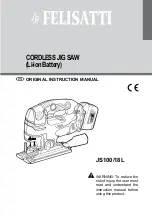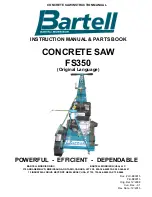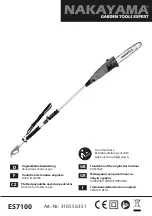
26
GB
• Important! Support long workpieces (e.g. with a roll-
er table) to prevent them sagging at the end of a cut.
• Make sure the blade guard (3) is in its lower posi-
tion when the saw is being transported.
•
Safety guards are not to be used to move or mis
-
use the machine.
•
Blades that are misshapen or damaged in any way
must not be used.
• If the table insert is worn, replace it.
• Never operate the machine if either the door pro-
tecting the blade or the detachable safety device
are open.
• Ensure that the choice of blade and the selected
speed are suitable for the material to be cut.
• Do not begin cleaning the blade until it has come
to a complete standstill.
• For straight cuts of small workpieces against the
longitudinal limit stop the push stick has to be used.
• The bandsaw blade guard should be in its lowest
position close to the bench during transport.
• For miter cuts when the table is tilted, the parallel stop
must be positioned on the lower part of the table.
• When cutting round timber, use a suitable holding
device to prevent the workpiece turning.
• Never use guards to lift or transport items.
• Ensure that the bandsaw blade guards are used
and correctly adjusted.
•
Keep your hands a safety distance away from the
bandsaw blade. Use a push stick for narrow cuts.
• The push stick has to be stored on the intended de-
vice, so that it can be reached from normal working
position and is always ready to be used.
• In the normal operating position the operator is in
front of the machine.
• When sawing wood, connect the band saw to a
dust collection device.
•
When cutting round or irregularly shaped wood,
use a suitable holding device that prevents the
workpiece from twisting.
6. Technical data
Electro motor
220 - 240 V ~, 50
Hz
Power
550W (S2 20min)
Revolutions
1400 min
-1
Saw band length
1790 mm
Saw band width
6 mm
Saw band width max.
13 mm
Saw band speed I
660 m/min
Saw band speed II
960 m/min
Cutting height
0 - 120 mm
Opening width
245 mm
Table size
300 x 300 mm
Slewing range of the table
0° bis 45°
Werkstückgröße max.
580x400x120 mm
Gewicht
24 kg
The work piece must have a minimum height of 3mm
and a minimum width of 10 mm.
* Duty type S2 – Short-time duty.
Operation at constant load for 20minutes or less, fol-
lowed by a time de-energized and at rest of sufficient
duration to re-establish machine temperatures within
2 K of the ambient temperature.
The total noise values determined in accordance
with EN 61029.
sound pressure level L
pA
77,4 dB(A)
uncertainty K
pA
3 dB
sound power level L
WA
90,4 dB(A)
uncertainty K
WA
3 dB
Wear hearing protection.
The effects of noise can cause a loss of hearing.
Total vibration values (vector sum - three directions)
determined in accordance with EN 61029.
7. Remaining hazards
The machine has been built using modern technolo-
gy in accordance with recognized safety rules. Some
remaining hazards, however, may still exist.
•
Risk of injury for fingers and hands by the rotating
saw band due to improper handling of the work piece.
•
Risk of injury through the hurling work piece due
to improper handling, such as working without the
push stick.
•
Risk of damaging your health due to wood dust and
wood chips. Wear personal protective cloth such
as goggles. Use a fitting dust extractor.
•
Risk of injury due to defective saw band. Regu
-
larely check saw band for such defects.
•
Risk of injury for fingers and hands while changing
saw band. Wear proper gloves.
•
Risk of injury due to starting saw band while
switching on the machine.
• The use of incorrect or damaged mains cables can
lead to injuries caused by electricity.
•
Wear only closefitting clothes. Remove rings,
bracelets and other jewelry.
•
For the safety of long hair, wear a cap or hair net.
Even when all safety measures are taken, some
remaining hazards which are not yet evident may
still be present.
•
Remaining hazards can be minimized by follow
-
ing the instructions in „General safety instructions“
„Proper Use“ and in the entire operating manual.
Summary of Contents for 5901505901
Page 2: ......
Page 3: ...Fig 4 Fig 4 1 b a 7 2 4 13 2 3 9 10 5 1 14 8 2 6 11 Fig 3 Fig 2 ...
Page 5: ...Fig 9 1 Fig 9 1 Fig 10 Fig 8 1 Fig 9 Fig 11 k o M L Q 8 N J 11 Fig 7 3 Fig 7 4 Fig 8 P k 5 d ...
Page 7: ...Fig 15 Fig 16 Fig 17 e e Fig 18 g f g e g f g e h h i i j R o m l 14 n k ...
Page 67: ...67 CZ ...
Page 103: ...103 EE ...
Page 127: ...127 ...
Page 128: ...128 R1 R2 C K2 K2 K1 S 230 240V ...
Page 129: ...129 ...
















































